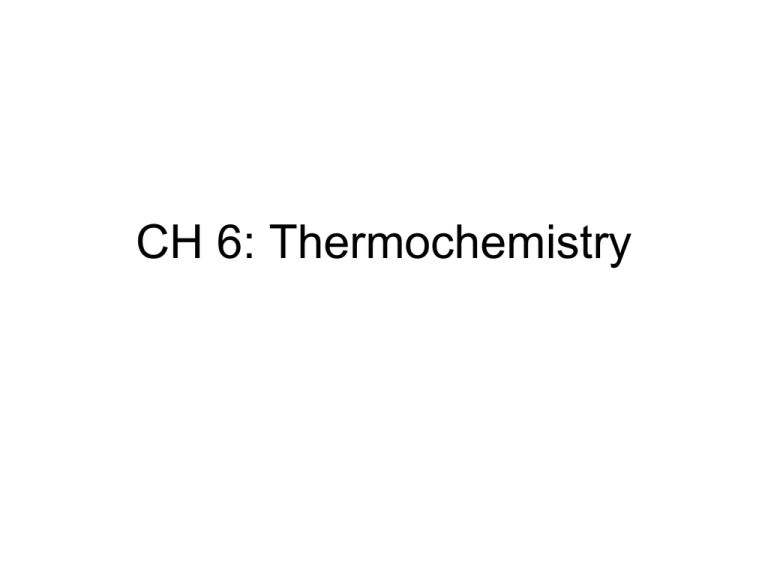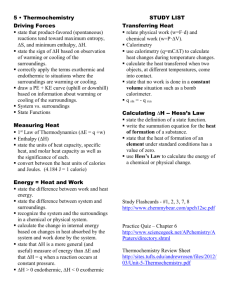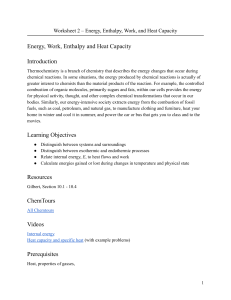CH 6 Powerpoint Slides
advertisement

CH 6: Thermochemistry 6.1 Nature of Energy • Thermochemistry – study of energy changes during chemical reactions – Aspects of thermochemistry are studied in both physics and chemistry 6.1 • Energy – the capacity to do work or produce heat • Law of conservation of energy states that energy can be converted from one form to another, but it cannot be created or destroyed. – Energy of the universe is constant! 6.1 Two forms of energy 1. Potential energy – stored energy • Energy of position or composition • Examples 2. Kinetic energy – energy of motion • Heat, light, electricity • In this chapter our focus will (eventually) be on the heat aspects of thermochemistry. 6.1 • Consider the diagram on page 237. • Ball A has potential energy due to its position – Some of this energy is released as heat as A rolls down the hill – Ball A hits Ball B and work is done as B moves up the incline • Work = force acting over a distance 6.1 • The original potential energy of A is equal to the new potential energy of B plus the heat released as friction. • Energy can be released as: – Heat (friction) – Work (ball rolling) 6.1 • The total energy released when ball A rolls down the hill is fixed – how it’s released is not. – How much is released as heat vs. work depends upon the conditions – Total energy released does not depend on the pathway. 6.1 • Total energy change is a state function. – State function is a property of a system that depends only on its current state not its past • See last paragraph on page 237 – Energy of a system is a state function. • Heat and work are not state functions – they depend on the path taken 6.1 Chemical Energy • When studying chemical change we consider the system and the surroundings. – System includes the reactants and products of a given reaction – Surroundings are everything else in the universe! • Including the water if the reaction is done in solution Chemical Energy • Exothermic reactions – energy flows out of the system – Products are of lower potential energy than the reactants • Energy is released to the surroundings • Energy lost by the system = energy gained by the surroundings – There’s a loss of energy by the system…. D Energy of the system is negative Chemical Energy • Endothermic reactions – energy flows into the system – Products are of higher potential energy than the reactants • The system absorbs energy from the surroundings • The energy gained by the system = the energy lost by the surroundings There’s a gain of energy by the system……. D Energy of the system is positive Chemical Energy • Exothermic: D E < 0 – System _______ energy • Endothermic: D E > 0 – System ________ energy More on Energy of the System • The energy of the system can change as a result of 2 factors: – Heat (q) – Work (w) • Change of energy of the system = heat flowing in/out of system + work being done to/by the system DE= q + w D E of the System • Heat (q) – When heat flows into the system, q > 0 • Endothermic – When heat flows out of the system, q < 0 • Exothermic • Work (w) – When work is done to the system, w > 0 – When work is done by the system, w < 0 More on Work • Most common form of work done by a system is the expanding or compressing of a gas, called pressure – volume work – Work – force applied over a distance • Moving an object a distance = work Pressure Volume Work • Consider a gas in a cylinder with a movable piston on top • Work = force x distance Force = pressure x area Distance = change in height of gas in cylinder (D h) • Work = P x A x D h D Volume • Page 241 Pressure Volume Work • Work = P x D V – The sign ( +/-) on work is assigned so that: • When the gas expands, it is doing work on the surroundings (w < 0) • When the gas is compressed, work is done on the system (w > 0) Pressure Volume Work • Final version of the equation that shows both magnitude and sign on work: W=-PxDV • When the gas expands D V is positive and w < 0 (work is done by the system) • When the gas is compressed D V is negative and w > 0 (work is done on the system) 6.2 Entahalpy • Enthalpy (H) – Enthalpy is defined as: H = E + PV • E is the energy of the system • P is the pressure of the system • V is the volume of the system Enthalpy • In chemistry we consider enthalpy at constant pressure – After much math this results in the formula: D H = qp D H is called the heat of the reaction DH is a measure of the flow of heat (q) into/out of the system at constant pressure Enthalpy • When heat leaves the system D H < 0 – Exothermic process • When heat enters the system D H > 0 – Endothermic process Finally – the Applications! CH4 + 2 O2 CO2 + 2 H20 + energy D H = - 890 kJ 1. Is the reaction exothermic or endothermic? 2. How much energy will be ___________ if 6.50 grams of CH4 is burned at constant pressure? Next…..#44 on page 277 Calorimetry • The heat changes associated with a chemical reaction are often measured in a calorimeter. Calorimetry • Exothermic: The heat released by the reaction is used to heat up a known quantity of water. • More heat released the hotter the water gets • Endothermic: The heat absorbed by the reaction comes from the water • More heat absorbed the colder the water gets Terms • Terms all describe the energy needed to heat or cool some amount of a given substance – Heat Capacity (C) – Specific heat capacity – Molar heat capacity Terms • Heat Capacity (C) – Amount of energy needed to raise the temperature of a substance by 10C – Units: J/0C – Substance is an entire/specific object…e.g. Terms • Specific Heat Capacity – Amount of energy needed to raise the temperature of 1 gram of a substance by 10C – Units: J/g0C – See page 245 Terms • Molar Heat Capacity – Amount of energy needed to raise the temperature of 1 mole of a substance by 10C – Units: J/mol 0C Molar heat capacity = specific heat x molar mass J/mol 0C = J/g 0C x g/mol Calculating Heat Capacities Heat Capacity = Specific Heat = Page 277: 52, 54 heat absorbed DT energy (mass) (D T) Determining Specific Heat of a Metal • Lab demonstration of experiment 27:E, page 347 of the lab manual – Assume the heat capacity of the ccc is 0 J/g0C










